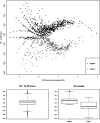Assessing differential item functioning for the Social Appearance Anxiety Scale: a Scleroderma atient-centred Intervention Network (SPIN) Cohort Study
- PMID: 33046467
- PMCID: PMC7552836
- DOI: 10.1136/bmjopen-2020-037639
Assessing differential item functioning for the Social Appearance Anxiety Scale: a Scleroderma atient-centred Intervention Network (SPIN) Cohort Study
Abstract
Objectives: The Social Appearance Anxiety Scale (SAAS) is a 16-item questionnaire developed to evaluate fear of appearance-based evaluation by others. The primary objective of this research was to investigate the existence of differential item functioning (DIF) for the 16 SAAS items, comparing patients who completed the SAAS in English and French, either to confirm that scores are comparable or provide guidance on calculating comparable scores. A secondary research objective was to investigate the existence of DIF based on sex and disease status. A tertiary research objective was to assess DIF related to language, sex, and disease status on the recently developed SAAS-5.
Design: This was a cross-sectional analysis using baseline data from patients enrolled in the Scleroderma Patient-centred Intervention Network (SPIN).
Setting: SPIN patients included in the present study were enrolled at 43 centres in Canada, USA, UK, France and Australia, with questionnaires completed in April 2014 to July 2019.
Participants: 1640 SPIN patients completed the SAAS in French (n=600) or English (n=1040).
Primary and secondary measures: The SAAS was collected along with demographic and disease characteristics.
Results: Six items were identified with statistically significant language-based DIF, four with sex-based DIF and one with disease type-based DIF. However, factor scores before and after accounting for DIF were similar (Pearson correlation >0.99), and individual score differences were small. This was true for both the full and shortened versions of the SAAS.
Conclusion: SAAS and SAAS-5 scores are comparable across language, sex, and disease-type, despite small differences in how patients respond to some items.
Keywords: anxiety disorders; rheumatology; statistics & research methods.
© Author(s) (or their employer(s)) 2020. Re-use permitted under CC BY-NC. No commercial re-use. See rights and permissions. Published by BMJ.
Conflict of interest statement
Competing interests: None declared.
Figures




References
-
- Kwakkenbos L, Willems LM, Baron M, et al. . The comparability of English, French and Dutch scores on the functional assessment of chronic illness Therapy-Fatigue (FACIT-F): an assessment of differential item functioning in patients with systemic sclerosis. PLoS One 2014;9:e91979. 10.1371/journal.pone.0091979 - DOI - PMC - PubMed
-
- Holland PW, Wainer H. Differential item functioning. Taylor & Francis, 2012.
Publication types
MeSH terms
Grants and funding
LinkOut - more resources
Full Text Sources
Medical
Miscellaneous
